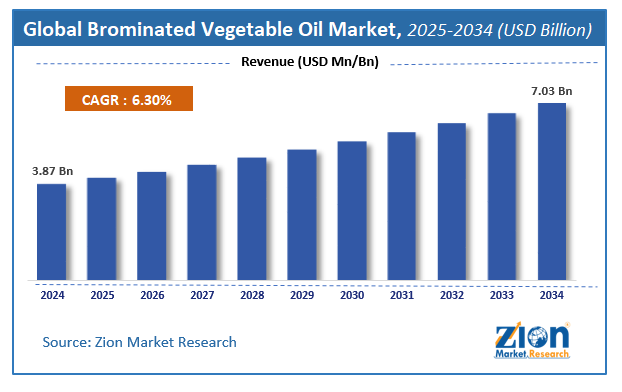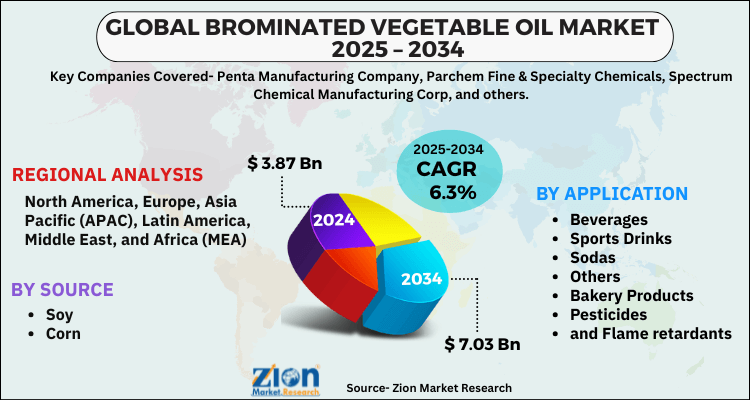Global Brominated Vegetable Oil Market Size, Share, Growth Analysis Report - Forecast 2034

Brominated Vegetable Oil Market By Source (Soy and Corn), By Application (Beverages, Sports Drinks, Sodas, Others, Bakery Products, Pesticides, and Flame retardants), and By Region: Global and Regional Industry Overview, Market Intelligence, Comprehensive Analysis, Historical Data, and Forecasts 2025 - 2034
| Market Size in 2024 | Market Forecast in 2034 | CAGR (in %) | Base Year |
|---|---|---|---|
| USD 3.87 Billion | USD 7.03 Billion | 6.3% | 2024 |
Brominated Vegetable Oil Market Size
The global brominated vegetable oil market size was worth around USD 3.87 Billion in 2024 and is predicted to grow to around USD 7.03 Billion by 2034 with a compound annual growth rate (CAGR) of roughly 6.3% between 2025 and 2034.
The report analyzes the global brominated vegetable oil market's drivers, restraints/challenges, and the effect they have on the demands during the projection period. In addition, the report explores emerging opportunities in the brominated vegetable oil industry.
Brominated Vegetable Oil Market: Overview
Brominated vegetable oil (BVO) is a complex mixture of triglycerides derived from plants that have bromine atoms attached to the molecules. Brominated vegetable oil is primarily used to emulsify citrus-flavored soft beverages and prevent separation during transportation. The drinks contain fatty citrus flavors such as orange, lemon, lime, and grapefruit. These flavors do not blend evenly and float to the top of the glass when added to a beverage. These aren't being disseminated properly. The emulsifier in brominated vegetable oil aids in the appropriate blending of the citrus taste in the soft drink.
In certain countries, the use of brominated vegetable oil in sodas is prohibited. Bromine, one of BVO's constituents, has been related to health problems. Bromine can irritate the skin and mucous membranes (the moist lining of the nose, mouth, lungs, and stomach). Long-term exposure can cause headaches, memory loss, and a loss of balance or coordination, among other neurological problems.
Key Insights
- As per the analysis shared by our research analyst, the global brominated vegetable oil market is estimated to grow annually at a CAGR of around 6.3% over the forecast period (2025-2034).
- Regarding revenue, the global brominated vegetable oil market size was valued at around USD 3.87 Billion in 2024 and is projected to reach USD 7.03 Billion by 2034.
- The brominated vegetable oil market is projected to grow at a significant rate due to growing applications in food safety and environmental testing, increasing pharmaceutical and biotechnology research, rising demand for drug discovery and quality control, and advancements in chromatography technologies.
- Based on Source, the Soy segment is expected to lead the global market.
- On the basis of Application, the Beverages segment is growing at a high rate and will continue to dominate the global market.
- Based on region, North America is predicted to dominate the global market during the forecast period.
Brominated Vegetable Oil Market: Growth Drivers
Extensive use in the beverage industry
The element is present in the majority of beverages. The oil may be present in about 10% of all soda products sold in the country, with citrus-flavored beverages being the most common. The global brominated vegetable oil market is expected to expand at a single-digit rate in the coming years.
Brominated Vegetable Oil Market: Restraints
Excessive consumption of brominated vegetable oil is not safe to be used as a food additive
Memory loss, tremors, weariness, lack of muscle coordination, ptosis of the right eyelid, and headaches have all been linked to excessive use of brominated vegetable oil. Chemical companies use the trademarked molecule as a flame retardant, which has resulted in its use in food being banned in Europe and Japan.
Brominated Vegetable Oil Market: Segmentation Analysis
The global brominated vegetable oil market is segregated based on source and application.
By source, the market is classified into Soy and Corn. Brominated vegetable oil (BVO) is vegetable oil, derived from corn or soy, and bonded with the element bromine.
By Application, the market is classified into Beverages, Sports Drinks, Sodas, Others, Bakery Products, Pesticides, and Flame retardants. Sports drinks, sodas, and other beverages have been divided into subcategories. Due to rising product consumption among consumers, the beverage category will account for the highest share of market growth.
Brominated Vegetable Oil Market: Report Scope
| Report Attributes | Report Details |
|---|---|
| Report Name | Brominated Vegetable Oil Market |
| Market Size in 2024 | USD 3.87 Billion |
| Market Forecast in 2034 | USD 7.03 Billion |
| Growth Rate | CAGR of 6.3% |
| Number of Pages | 110 |
| Key Companies Covered | Penta Manufacturing Company, Parchem Fine & Specialty Chemicals, Spectrum Chemical Manufacturing Corp, and others. |
| Segments Covered | By Source, By Application, and By Region |
| Regions Covered | North America, Europe, Asia Pacific (APAC), Latin America, The Middle East and Africa (MEA) |
| Base Year | 2024 |
| Historical Year | 2020 to 2023 |
| Forecast Year | 2025 - 2034 |
| Customization Scope | Avail customized purchase options to meet your exact research needs. Request For Customization |
Brominated Vegetable Oil Market: Regional Landscape
North America is the largest market for brominated vegetable oil, and it is likely to remain so throughout the projection period. This could be due to the strong demand for various beverages in the region, which has boosted sales of brominated vegetable oil. The Asia Pacific area, which is home to the world's second-largest brominated vegetable oil market, is predicted to grow fast due to rising population and bakery product output. Growing economies such as India and China are primarily responsible for the demand created in this region. In Western Europe, Germany is expected to have the biggest proportion.
Brominated Vegetable Oil Market: Competitive Analysis
The report provides a company market share analysis to give a broader overview of the key market players. In addition, the report also covers key strategic developments of the market, including acquisitions & mergers, new product launches, agreements, partnerships, collaborations & joint ventures, research & development, and regional expansion of major participants involved in the brominated vegetable oil market on a global and regional basis.
The global brominated vegetable oil market is dominated by players like:
- Penta Manufacturing Company
- Parchem Fine & Specialty Chemicals
- Spectrum Chemical Manufacturing Corp
The global brominated vegetable oil market is segmented as follows;
By Source
- Soy
- Corn
By Application
- Beverages
- Sports Drinks
- Sodas
- Others
- Bakery Products
- Pesticides
- and Flame retardants
By Region
- North America
- The U.S.
- Canada
- Mexico
- Europe
- France
- The UK
- Spain
- Germany
- Italy
- Rest of Europe
- Asia Pacific
- China
- Japan
- India
- Australia
- South Korea
- Rest of Asia Pacific
- The Middle East & Africa
- Saudi Arabia
- UAE
- Egypt
- Kuwait
- South Africa
- Rest of the Middle East & Africa
- Latin America
- Brazil
- Argentina
- Rest of Latin America
Table Of Content
Methodology
FrequentlyAsked Questions
The global brominated vegetable oil market is expected to grow due to increasing use as an emulsifier in citrus-flavored soft drinks, rising demand for flavored beverages, growth in the food and beverage industry, and regulatory developments affecting its usage.
According to a study, the global brominated vegetable oil market size was worth around USD 3.87 Billion in 2024 and is expected to reach USD 7.03 Billion by 2034.
The global brominated vegetable oil market is expected to grow at a CAGR of 6.3% during the forecast period.
North America is expected to dominate the brominated vegetable oil market over the forecast period.
Leading players in the global brominated vegetable oil market include Penta Manufacturing Company, Parchem Fine & Specialty Chemicals, Spectrum Chemical Manufacturing Corp, among others.
The report explores crucial aspects of the brominated vegetable oil market, including a detailed discussion of existing growth factors and restraints, while also examining future growth opportunities and challenges that impact the market.
RelatedNews
HappyClients
Zion Market Research
Tel: +1 (302) 444-0166
USA/Canada Toll Free No.+1 (855) 465-4651
3rd Floor,
Mrunal Paradise, Opp Maharaja Hotel,
Pimple Gurav, Pune 411061,
Maharashtra, India
Phone No +91 7768 006 007, +91 7768 006 008
US OFFICE NO +1 (302) 444-0166
US/CAN TOLL FREE +1 (855) 465-4651
Email: sales@zionmarketresearch.com
We have secured system to process your transaction.
Our support available to help you 24 hours a day, five days a week.
Monday - Friday: 9AM - 6PM
Saturday - Sunday: Closed






